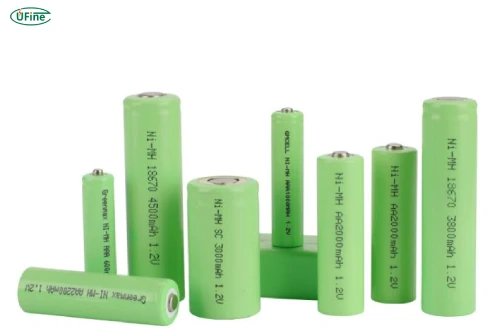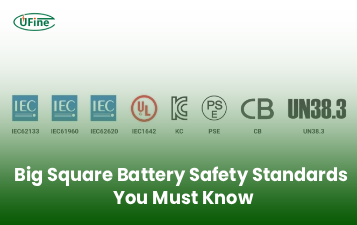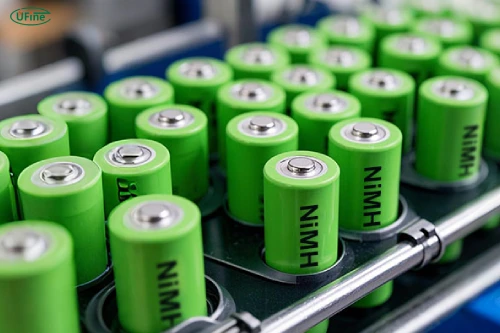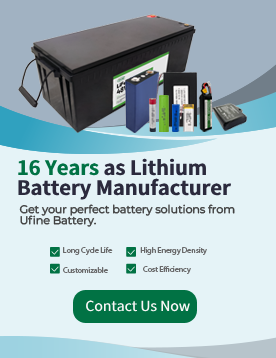
- Part 1. What is a NiMH rechargeable battery?
- Part 2. Factors affecting NiMH battery lifespan
- Part 3. Average lifespan of NiMH rechargeable batteries
- Part 4. Capacity and voltage considerations
- Part 5. Charging tips to extend lifespan
- Part 6. Maintenance practices for NiMH batteries
- Part 7. Signs your NiMH battery is reaching end of life
- Part 8. How device usage impacts battery life
- Part 9. NiMH battery types and longevity comparison
- Part 10. FAQs
Part 1. What is a NiMH rechargeable battery?
A NiMH rechargeable battery is built on the Nickel–Metal Hydride chemistry. Unlike older nickel-cadmium (NiCd) batteries, NiMH cells replace the toxic cadmium with a hydrogen-absorbing alloy, making them eco-friendlier and safer for household use.
Key characteristics of NiMH batteries include:
- Nominal voltage: 1.2V per cell, slightly lower than alkaline batteries (1.5V), but stable under load.
- Capacity range: Common AA and AAA cells range from 600mAh to 2,700mAh, while C and D cells can reach 4,000mAh.
- Rechargeability: Typically supports 500–1,000 charge/discharge cycles.
- Self-discharge: Standard NiMH cells lose about 1–3% of their charge per day, while low self-discharge versions retain up to 70–85% after one year.
NiMH batteries are ideal for high-drain devices like digital cameras, motorized toys, and flashlights. Unlike disposable alkaline batteries, NiMH batteries provide long-term cost savings and reduce environmental waste.
Part 2. Factors affecting NiMH battery lifespan
The lifespan of a NiMH rechargeable battery depends on several key factors. Understanding these will help you extend the performance of your batteries.
1 Charge and Discharge Cycles
NiMH batteries have a finite number of full charge/discharge cycles, usually between 500 and 1,000. A cycle is counted when a battery is fully discharged and then recharged. Partial discharges count proportionally — for example, two 50% discharges equal one full cycle.
Frequent deep discharges can wear out cells faster, while shallow discharges tend to extend their life. Many devices, such as cameras or toys, benefit from moderate, partial discharges rather than full drains.
2 Usage Patterns
High-drain devices consume battery energy rapidly, leading to faster cycling. Devices like high-powered flashlights, remote-controlled drones, or professional cameras will shorten the battery’s effective life compared to low-drain applications like clocks or remote controls.
3 Temperature
Extreme temperatures significantly affect NiMH battery performance:
- High temperatures (above 40°C / 104°F) accelerate chemical degradation.
- Low temperatures (below 0°C / 32°F) reduce immediate capacity and may cause internal stress during charging.
Proper temperature control during storage and use can prolong the battery’s lifespan.
4 Charging Habits
How you charge your NiMH rechargeable batteries plays a critical role in longevity. Overcharging, using incompatible chargers, or charging at excessively high currents can degrade cells.
Smart chargers with automatic cutoffs prevent overcharging, while trickle chargers supply a slow, steady current suitable for low self-discharge NiMH batteries. Ufine Battery emphasizes the use of quality chargers and proper charging protocols to maximize performance.
Part 3. Average lifespan of NiMH rechargeable batteries

The average lifespan of a NiMH rechargeable battery depends on the combination of usage patterns, charging behavior, and storage. Here’s what you can expect:
Cycle life: 500–1,000 full cycles under optimal conditions.
Runtime per charge:
- AA: 600–2,700mAh depending on cell quality and device drain
- AAA: 600–1,000mAh
- C/D: 3,000–4,000mAh
Self-discharge: Standard NiMH loses about 1–3% per day, whereas low self-discharge types retain most of their charge for months.
Low self-discharge (LSD) NiMH batteries, such as Panasonic Eneloop or Ufine Battery’s custom cells, are ideal for standby devices like remotes, smoke detectors, or emergency flashlights, providing longer usability between charges.
Part 4. Capacity and voltage considerations
Understanding capacity and voltage is essential when evaluating how long a NiMH battery lasts.
- Capacity (mAh): A higher milliamp-hour (mAh) rating means longer runtime per charge. For example, a 2,500mAh AA battery will last longer in a high-drain camera than a 1,500mAh battery.
- Voltage stability: NiMH batteries maintain a nearly flat voltage throughout discharge, unlike alkalines which gradually drop. This stability ensures consistent performance for devices sensitive to voltage dips.
- Device compatibility: Always match the battery type (AA, AAA, C, D, 9V) and capacity to the device requirements to avoid poor performance or premature wear.
Part 5. Charging tips to extend lifespan
Proper charging is one of the most important ways to extend the life of NiMH rechargeable batteries.
Recommended Practices:
- Use the right charger: Always select a charger compatible with NiMH chemistry. Smart chargers prevent overcharging and automatically stop when the battery is full.
- Avoid overcharging: Continuous charging after the battery reaches full capacity generates heat and reduces cycle life.
- Charge at moderate currents: Standard charging currents between 0.1C and 0.5C are ideal. High currents can increase internal temperature and reduce lifespan.
- Partial charging: NiMH batteries tolerate partial charges well, and shallow discharges combined with moderate charging can extend total cycle life.
Ufine Battery recommends smart chargers with built-in temperature sensors and voltage monitoring to protect cells and maximize longevity.
Part 6. Maintenance practices for NiMH batteries
Proper maintenance is essential for extending the effective life of NiMH batteries:
- Store partially charged: For long-term storage, keep batteries at 40–60% charge.
- Periodic cycling: Even unused batteries benefit from occasional discharge/recharge cycles.
- Keep contacts clean: Wipe terminals to remove corrosion or dirt. Dirty contacts can increase internal resistance and reduce effective runtime.
- Avoid extreme heat or moisture: Store batteries in a cool, dry environment.
Following these practices ensures your batteries retain capacity and provide consistent performance over time.
Part 7. Signs your NiMH battery is reaching end of life
Knowing when a NiMH rechargeable battery is nearing the end of its useful life helps prevent device failures. Common signs include:
- Reduced runtime: The battery drains much faster than when new, even after a full charge.
- Increased charging time: Cells take longer to reach full charge.
- Swelling or leakage: Physical deformation indicates internal chemical breakdown.
- Voltage drops: Cells cannot maintain stable voltage under load.
Part 8. How device usage impacts battery life
The type of device and how it’s used significantly influences the lifespan of NiMH rechargeable batteries:
- High-drain devices: Digital cameras, RC toys, and power tools require rapid current draw, which increases the rate of chemical wear.
- Low-drain devices: Remote controls, clocks, and smoke detectors allow batteries to last longer and undergo fewer full cycles.
- Standby vs. continuous use: Batteries in standby devices can last months without recharge, while batteries in continuous-use devices need more frequent charging, reducing total cycle life.
Understanding your device’s power demand can help choose the right NiMH battery type and manage charging frequency effectively.
Part 9. NiMH battery types and longevity comparison
NiMH batteries come in several variations, each affecting lifespan and usability:
1 Standard NiMH
- Affordable and widely available
- Moderate self-discharge (loses ~1–3% per day)
- Best for high-drain devices used frequently
2 Low Self-Discharge (LSD) NiMH
- Holds 70–85% charge for months
- Ideal for standby or emergency devices
- Slightly lower maximum capacity than standard cells
3 High-Capacity NiMH
- Designed for heavy-duty devices
- Higher mAh ratings (up to 2,700mAh for AA)
- Slightly shorter cycle life compared to standard NiMH
Part 10. FAQs
How often should I recharge NiMH batteries to maintain lifespan?
Recharge them when they drop to 20–50% charge for frequent use. Avoid deep discharges unless occasional recalibration is needed.
Can I mix old and new NiMH batteries in a device?
It’s not recommended. Mixing can cause voltage imbalance and reduce runtime or damage the new cells.
Do NiMH batteries suffer from memory effect?
Compared to NiCd batteries, NiMH has minimal memory effect. Occasional full discharge helps maintain accurate charge capacity but is not required frequently.
How long do low self-discharge NiMH batteries hold charge?
LSD NiMH batteries can retain 70–85% of charge after 1 year, making them ideal for backup devices or emergency kits.
Can extreme cold or heat permanently damage NiMH batteries?
Yes. Charging or using batteries outside recommended temperature ranges can reduce capacity and cycle life. Store and charge between 0°C–40°C for best results.
Are all AA/AAA NiMH batteries interchangeable?
Yes, physically they fit, but capacity, discharge rate, and device drain requirements should be considered for optimal performance.
Related Tags:
More Articles

Big Square Battery Safety Standards You Must Know
Learn key safety standards for big square batteries to avoid fire risks, shipping delays, and compliance issues in EV, industrial, and energy storage projects.
Big Square Battery Applications in Solar & Industrial Equipment
Big square batteries deliver high capacity, stable output, and long life for solar, industrial, and backup power. Explore key uses and advantages.
Big Square Battery vs Cylindrical Battery: Complete 2025 Guide for EVs, ESS & Industrial Devices
Choosing the right battery is key for designers and engineers. Compare big square vs cylindrical batteries to find the best fit for your application.
How to Choose the Right Big Square Battery for Your Device?
If you’re choosing a big square battery for EVs, solar, or mobility devices, this guide helps you pick the right solution for real-world needs.
Big Square Battery Complete Guide: Types, Uses & Buying Tips
If you are choosing a big square lithium battery for EVs, solar, RVs, or AGVs, this guide helps you select the right NMC, LFP, or LTO solution with examples.



